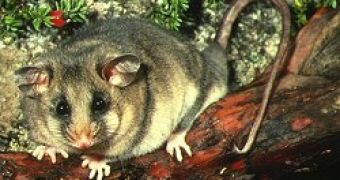When you hear about hibernation, you instantly think about the northern snowed plains and marmots, ground squirrels and hedgehogs. But in the generally snowless Australia, its highest mountains are the 'home' of the only hibernating marsupials. The mountain pygmy possum (Burramys parvus) was first discovered as a fossil till the first individual of this mouse-sized species was captured in 1966 in a ski hut on Mount Hotham.
A new research made at the University of Melbourne and La Trobe University and published in the British journal Biology Letters warns that the development of ski resorts is pushing towards extinction this already endangered living fossil, in the most rapid loss of genetic diversity ever described for a mammal species.
"Pygmy possums at Mount Buller (Victoria) have been in rapid decline in the last few years. Their genetic diversity has plummeted by more than two thirds over the last 10 years and this has been caused by habitat loss due to ski resort development," said co-author Andrew Weeks, a geneticist.
The mountain pygmy-possum is restricted to alpine areas of southeastern Australia: southern Victoria (Mount Buller and Bogong High Plains) and Mount Kosciusko in Kosciuszko National Park in New South Wales. In 2003, a big chunk of the species habitat was burnt by a violent bush fire, boosted by ski resort development.
Boulder fields are the species' preferred habitat but are also the best locations for ski fields. Habitat loss and predators introduced by Europeans (like cats and foxes) have plummeted the possum's population under 1,800 adults and the tendency is downward. The team investigated populations in the Bogong High Plains, afflicted by the 2003 burn, and two populations at Mount Buller: in the first case, ski-connected development wiped out 80 % of the possum's habitat; the other being an undeveloped area, but with a less than optimum habitat for the possum.
DNA investigation for genetic diversity found a significant drop in population's size and genetic diversity, while the fire-affected areas and poor habitats revealed a steady evolution in genetic diversity and population size, compared to previous data. "We have shown that levels of genetic variation in possum populations were unaffected by the 2003 fires' but there was a rapid loss of genetic variation following resort expansion at Mount Buller. The most immediate threats to the mountain pygmy-possums existence is human developments, not natural catastrophes or climate change," said Weeks.
"The results show that resort developments need to proceed in a sensitive manner that preserves possum habitats intact. Individuals from other populations will need to be introduced to prevent inbreeding and increase their genetic variation," said co-author Paul Mitrovski.

 14 DAY TRIAL //
14 DAY TRIAL //